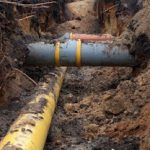Pipeline transportation is the mode of transportation that involves the use of large, hollow pipes to convey water, beer, crude oil, gas, and biofuels. Compared to the use of trailers or tankers, this mode is considered safer and cheaper by manufacturers.
Pipelines were originally used to convey water for both drinking and irrigation over long distances with difficult terrains. However, today, its use is not limited to water as it is now used for several commodities. Some of these commodities include natural gas, heavy gas products like butane and propane, oil, milk, and some solids like liquified coal, also known as Slurry. Click here to learn more about coal slurry.
Pipelines travel over diverse locations that are difficult to access during regular operations. To be installed safely and efficiently, the lands they are to travel through are temporarily acquired from the landowners by the pipeline operator. Upon completion of the project, these lands are returned to the owners.
The lines are often buried deep in the ground to limit access to them intentionally or unintentionally. Because of this, they are constructed in such a way that they require minimal human intervention to operate efficiently and safely. The responsibility of meeting such high reliability and quality standards rests on the first building blocks of any pipeline- the line pipes.
Table of Contents
What are Line Pipes?
Line pipes are a type of pipe that is manufactured from high-strength carbon steel. Typically, they are made to meet the metallurgical specifications developed by the American Petroleum Institute (API). As we mentioned earlier, they are the building blocks for pipelines used to transport different resources.
Available in different diameters ranging from 2’’ to 28’’, line pipes can include seamless, stainless steel, or welded carbon steel piping. Because they are used for a wide variety of high-pressure applications, several important tests are carried out on these pipes to ensure they meet all the necessary requirements. When it comes to pipeline transportation, the quality and integrity of line pipes should never be compromised if an operator is to run a reliable pipeline service.
Basic Requirement for Line Pipes
- They should be able to resist weathering during transportation, storage, and service.
- Since pipeline girth welding is done on-site and under extreme conditions, their metallurgical properties should be able to tolerate all the complexities of field welding.
- Their chemical and mechanical properties must be such that the girth weld retains its integrity throughout the lifespan of the pipes.

Types of Transportation Pipelines
Pipelines vary based on the materials that they convey. Here are a few of them:
Oil and Gas
Oil and natural gas are conveyed from where they are produced to where they are refined and then back to the market through pipelines. However, these resources can and are transported through other means like barge, tanker, and train. Although efficient, they aren’t as safe and cost-effective as the use of pipelines.
Water and Sewer
Water pipelines are used to transport water from treatments plants to consumers in the towns and cities. These lines vary in size and function with the larger main pipes, also known as mains supplying water to the entire town or city while smaller branch pipes supply a group of buildings or a street.
They are usually laid a few feet underground, forming a network under streets and cities. Sewer pipes, on the other hand, are used to transport wastes directly to sewers from homes, offices, hospitals, schools, and other properties.
Slurry
These are pipes specially designed to transport ores such as iron, coal, or even mining wastes known as tailings. To convey these materials, they are mixed with water becoming what is called “slurry” and then pumped through the pipe to their destination where they are filtered.
Because coal slurry has abrasive properties, the pipelines are usually lined on the inside with high-density polyethylene (HDPE). Railroad transportation was mostly used to move ores. However, pipelines are becoming very popular in the mining industry, especially for mines that are in inaccessible areas. Compared to railroad transport, it has more economic advantage and generates much less noise. Visit https://sciencing.com/hdpe-plastic-5839257.html to learn more about HDPE.
Advantages and Disadvantages of Pipeline Transportation
Advantages
- Large volumes of resources can be transported continuously, unaffected by weather
- Energy consumption is the lowest among every other mode of transportation
- Environmentally friendly compared to other modes
- Can take shortcuts, thereby helping to cut travel distances
- Safe, reliable, and cost-effective
- Requires minimal maintenance
- Can be laid through difficult terrains, including underwater.
Disadvantages- Pipeline Transportation
- Once laid, its capacity cannot be increased
- Can only be used for a few fixed points
- Faults and damages in underground pipelines are difficult to detect and repair
- Transportation items are limited to fluids, gases, and liquids.
- Fixed investment is large.
Final Thoughts
Items that can be conveyed with this mode of transportation are indeed limited, however, it remains a fact that these items are conveyed much more efficiently, safely, and with considerably lower costs compared to other modes of transportation.













